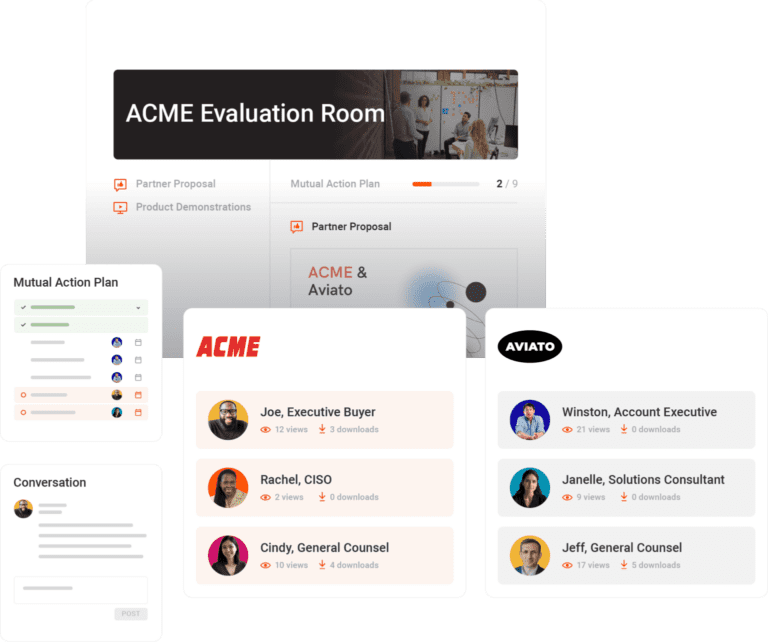On average, there are 27 interactions in the buyer journey before a decision is reached. These interactions range from phone conversations to email chains to instant messaging. Each step is an instance where information can be misplaced or forgotten, and sales momentum lost.
The good news is that this type of back-and-forth communication can be replaced with a digital sales room — a single and permanent location for potential buyers to find all your sales information instantly.
Digital sales rooms (DSRs) give prospects a personalized buying journey with content that is tailored to their business needs and goals. As well, they help sales reps understand which content leads to closed deals and improved close rates.
What you’ll learn:
- How digital sales rooms streamline the buying journey
- Why empowering buyers can improve your close rates
- How to create compelling buying experiences using DSRs
What are digital sales rooms and how do they work?
Digital sales rooms work through a client-seller portal. Here, sales reps create a DSR or virtual sales platform, which essentially serves as a resource and storage location for all the content a buyer needs to make an informed purchase decision.
Similar to a showroom, digital sales rooms are created specifically for each customer, where they can view product demos, have their questions answered, and keep track of all the conversations and information they have with your reps. Depending on the needs of the buyer, content can include product proposals, testimonies, order forms, or service proposals. Once the portal is created, buyers are given access through a unique link.
Digital sales rooms are also connected to sales enablement platforms. This is an added benefit for sales reps, as they can gather insights on how prospects interact with content and where further content needs to be included for future negotiations.

Digital sales rooms empower your buyers
Digital sales rooms improve close rates by empowering buyers with all the information they need to confidently finalize a purchase. Thanks to the personalized sales cycles and customized content management DSRs offer, Gartner predicts that by 2026, 30% of B2B sales cycles will be managed through their use.
Digital sales rooms improve the digital sales experience by:
- Offering a platform to answer any questions or concerns with instant two-way communication
- Improving engagement with customers through an interactive portal
- Improving understanding of buyer behavior and the buyer journey by capturing data on client interactions and patterns
- Providing access to the newest product features and offerings
- Building relationships, providing content to address questions, and helping clients feel supported and valued
These days, only 17% of the B2B buying cycle is spent with a sales rep. With digital sales rooms, buyers can drive the sales cycle but the content they interact with is still controlled and delivered by sellers.
How to create compelling custom buying experiences using DSRs
If you’re thinking about introducing a DSR into your selling process, follow these tips to close more deals.
Personalize the digital sales room experience to your buyer
Your digital sales room should help your prospect through their buyer journey, aiding in their research without overwhelming them with irrelevant content.
Upload content that is meaningful and relevant to your buyer. For example, if your prospect is at the start of their journey, they’ll be interested in content that explains product features and articles on comparisons with competitors. However, if they’re closer to signing off on the purchase, content for next steps, like payment options and implementation processes, will be more relevant.
To know which content to include, ask yourself:
- What are your prospects searching for on the internet?
- At what stage are they in their buyer journey?
- What solutions does your product provide for their business?
- What roadblocks are preventing them from buying?
- Do they need to share this content with other stakeholders?
To drive high buyer engagement, Include content that has already proved itself based on data from your sales enablement platform or past experience.
Where possible, personalize the content to include the prospect’s name, position, and company. So content is being received in the most persuasive way possible, you can even use terminology that is specific to their industry.
Have support accessible at all times
If your buyer doesn’t find the information they need immediately, you risk them getting frustrated and looking for answers elsewhere, potentially with a competitor.
In your digital sales room, it’s a good practice to include a support channel that is accessible at all times. Or, have an in-room chat option to ask and answer any buyer questions in a centralized platform where no information will be lost.
Make your content unique with purposeful interaction
Your content needs to meet your buyer at their stage of the journey. Answer the questions they have at that stage and guide them through the digital sales experience to the next. But that certainly doesn’t mean that your content should be monotonous.
On the contrary, your potential buyers should feel curious to learn about your product through content that is interactive and engaging.
You want prospects to remember your content, and that means forgoing long Word documents and instead leaning into videos, infographics, product demos, slide shows, and fun visual documents.
Always make the next steps clear
Guide the buyer down the sales funnel with clear next steps and actions. Not only does this direct prospects to the final closure, but it also gives insight into prospective roadblocks in the process and indicates where content is missing. Some things to keep in mind:
- Create and embed customized CTAs into each content piece to drive the buyer through their learning journey.
- Create a checklist or an action plan built from past successful seller experiences outlining what the next steps or content to consume should be.
With clear next steps, you make sure that the buyer is staying on track and making progress toward their final purchase.
Keep the content on brand to elevate purchase desire
You want buyers to feel the brand throughout the buying process so that they establish a connection with your product. Here are things to keep in mind:
- Deliver your brand’s value and purpose to your buyer with every content interaction
- Customize your digital sales rooms to reinforce the look and feel of your company
- Position your content as an enhancement of your business values and tone
By keeping your content on brand, you avoid creating false expectations. Instead, your content clearly communicates the benefits and objectives the product can fulfill.
Include a product demo
Product demos give users an opportunity to see firsthand the benefits your product or service can provide.
Access to demos helps prospects fully understand the features and product capabilities as well as allowing them to imagine the time they can save and the problems they can solve by using your product.
With demos available, sellers can directly question the prospect’s particular needs and show them how to solve their problems.
Your DSR is only as good as your sales content
When you’ve got a great potential buyer visiting your digital sales room, the real driver is the content you provide.
Use insights from past sales processes to deliver the most impactful content to your buyers at each stage of the buyer journey. This will enhance the buyer experience and simplify the selling process. The sales materials should educate the buyer without hard selling the product or service. The idea is to help the buyer become empowered in their purchase decision.
Ready to see DSRs in Action?
One secure, shared space for all content, communication, and deal planning.
Request a DemoThis post was originally published in October 2022, was updated in August 2023, and again in January 2024.








